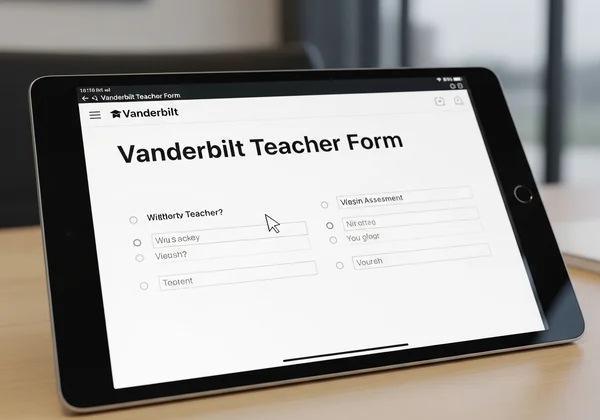Vanderbilt Assessment Teacher Form: Your Guide to ADHD Screening in Schools
Are you an educator noticing a student struggling with attention or hyperactivity in class? You're not alone. Many dedicated teachers seek effective ways to understand and support their students. The Vanderbilt Teacher Form can be a crucial tool in identifying potential Attention-Deficit/Hyperactivity Disorder (ADHD) and other behavioral concerns. This comprehensive guide will walk you through understanding, using, and interpreting this standardized assessment to better support your students aged 6-12 and facilitate essential communication with parents and school support teams. Ready to gain clearer insights into student behavior? Start your assessment today.
Understanding the Vanderbilt ADHD Teacher Form
As a teacher dedicated to student well-being, knowing which tools can truly help is incredibly important. The Vanderbilt ADHD Teacher Form is a widely recognized and respected assessment that provides a structured way to observe and document student behaviors.
What is the Vanderbilt Assessment? A Brief Overview
The Vanderbilt Assessment Scale is a standardized rating scale developed by the National Institute for Children's Health Quality (NICHQ) to help identify symptoms of ADHD and other co-occurring behavioral problems in children aged 6 to 12. There are two primary versions: one for parents and one for teachers. While both are critical, the Vanderbilt Teacher Form offers a unique classroom perspective. This overview of assessment provides a baseline for understanding its utility.
Why the Teacher Form is Essential for Student Behavior Assessment
Teachers spend a significant portion of the day with students, observing their behavior in a structured learning environment. This unique vantage point makes the teacher's input invaluable when assessing concerns like inattention, hyperactivity, and impulsivity. The teacher's role in assessment is crucial because it captures behaviors that might not be as apparent at home. This systematic approach to student behavior assessment allows for consistent and objective data collection, which is vital for informed decision-making and developing targeted interventions. It plays a key part in early classroom ADHD screening.

How to Effectively Use the Vanderbilt for Classroom ADHD Screening
Utilizing the Vanderbilt Assessment Teacher Form effectively can provide significant clarity. Here’s a practical guide to leveraging this powerful tool in your classroom.
Accessing the Official Vanderbilt Teacher Form Online
Gone are the days of manual scoring and paper forms. Our platform offers a convenient and secure way to access the official online Vanderbilt assessment teacher form. This digital platform provides instant, automated scoring, saving you valuable time. To begin, simply visit the homepage and select the teacher version to access the form. It's designed for ease of use, ensuring that every educator can complete the assessment with minimal fuss. For easy online form access, simply visit our site.

Practical Tips for Filling Out the Assessment Accurately
Accuracy is key when completing any assessment. When filling out the Vanderbilt Teacher Form, focus on observable behaviors you’ve witnessed in the classroom over a recent period, typically the past six months. Consider different settings within the school day, such as during independent work, group activities, or transitions. Be honest and objective, avoiding generalizations or assumptions. This meticulous attention to detail ensures the assessment yields reliable results. Remember, your comprehensive observations are truly invaluable for painting a full picture of the student's behavior.
Key Sections and What Behaviors to Observe
The Vanderbilt Assessment Teacher Form organizes observations into clear sections, helping you focus on specific behaviors and symptom clusters. These include:
- ADHD Inattentive Symptoms: Look for behaviors like difficulty sustaining attention, making careless mistakes, not listening, failing to follow through on instructions, and being easily distracted.
- ADHD Hyperactive-Impulsive Symptoms: Observe restlessness, fidgeting, excessive talking, difficulty waiting turns, and interrupting others.
- Oppositional Defiant Disorder (ODD) Symptoms: Note patterns of defiant, hostile, or uncooperative behavior towards authority figures.
- Conduct Disorder (CD) Symptoms: Look for more severe patterns of aggression, destruction of property, deceitfulness, or rule-breaking.
- Anxiety/Depression Symptoms: Pay attention to signs of excessive worry, sadness, loss of interest, irritability, or changes in sleep/appetite.
Paying close attention to these observing key behaviors across various classroom situations will strengthen the assessment's utility.
Interpreting Student Behavior Assessment Results
Once the Vanderbilt Assessment Teacher Form is completed, understanding the results is the next crucial step. The online platform provides immediate, standardized reports.
Decoding the Score: What Numbers Mean for Classroom Behavior
The scores on the Vanderbilt Assessment are not diagnostic. Instead, they indicate the frequency and severity of certain behaviors, highlighting areas where a student might be exhibiting symptoms consistent with ADHD or other conditions. Higher scores in specific symptom clusters suggest a greater concern in those areas. This score interpretation guides teachers on what behaviors warrant further attention. For example, a high score in the inattentive domain might point to a need for specific classroom accommodations. The report acts as a valuable discussion starter, not a definitive label.
Communicating Results with Parents and School Support Teams
The Vanderbilt Assessment Teacher Form is a powerful tool for initiating conversations with parents and other school professionals. When discussing the results, emphasize that this is a screening tool, not a diagnosis. Share your objective observations and how the assessment helps quantify those observations. Focus on supporting the student, and present the findings collaboratively. Effective parent-teacher communication is vital for ensuring the child receives appropriate support. You can encourage parents to use the Vanderbilt Assessment parent form on our site to provide a complete picture of the child's behavior. To explore more about how the AI-powered report can enrich these conversations, learn more here.

Empowering Educators: Your Role in Student Support
As educators, your insights are invaluable. The Vanderbilt Teacher Form empowers you with a structured, objective method to document your observations and advocate for your students. It's a proactive step in ensuring that children who may be struggling receive the attention and support they need to thrive. By utilizing this classroom ADHD screening tool, you contribute significantly to early identification and intervention efforts. Your diligent use of resources like the online Vanderbilt Assessment teacher form makes a tangible difference in students' lives.
Frequently Asked Questions for Educators on Vanderbilt Assessment
We understand educators have specific questions about using assessment tools in the classroom. Here are some common inquiries regarding the Vanderbilt Assessment Teacher Form.
What specific conditions does the Vanderbilt Assessment Teacher Form screen for?
The Vanderbilt Assessment Teacher Form primarily screens for symptoms consistent with ADHD (inattentive, hyperactive-impulsive, and combined types). However, it also includes sections to screen for co-occurring conditions that often present alongside ADHD, such as Oppositional Defiant Disorder (ODD), Conduct Disorder (CD), and symptoms of anxiety and depression. This broad screening helps teachers get a comprehensive view of a student's behavioral profile. To understand the full scope of the assessment, visit our homepage.
How accurate is the Vanderbilt ADHD Teacher Assessment in identifying concerns?
The Vanderbilt Assessment is a highly respected and widely used ADHD screening tool developed by NICHQ. While it is not a diagnostic instrument, it is considered very accurate for identifying behaviors and symptoms that warrant further professional evaluation. Its standardized nature ensures consistency and reliability in student behavior assessment. When used as intended—as a screening tool to guide discussions with parents and medical professionals—it is an incredibly valuable and trusted resource.
Can the Vanderbilt Teacher Form be used to track progress over time?
Yes, the Vanderbilt Assessment Teacher Form can be a useful tool for tracking a student's behavioral progress over time. By completing the form periodically (e.g., every 3-6 months or after implementing new interventions), educators can observe changes in symptom frequency and severity. This longitudinal data can be incredibly helpful for evaluating the effectiveness of classroom strategies or other interventions. Remember, consistency in observation and reporting is key to accurate progress monitoring.
Where can educators find the official Vanderbilt Teacher Form online for free?
Educators can easily find and utilize the official Vanderbilt Teacher Form online right here on our platform. Our platform offers a convenient and secure way to complete the assessment and receive immediate, automated results. We pride ourselves on providing an accessible and user-friendly experience for teachers seeking to better understand their students' behavioral needs. Access the online form now to get started.